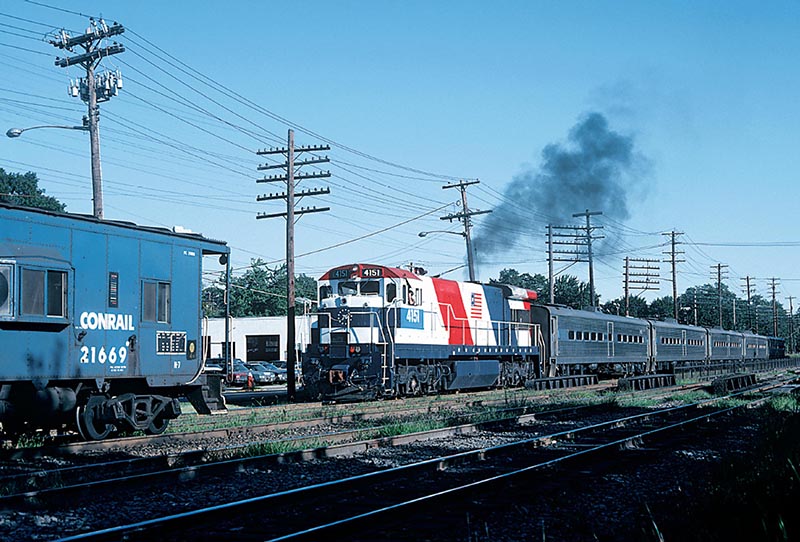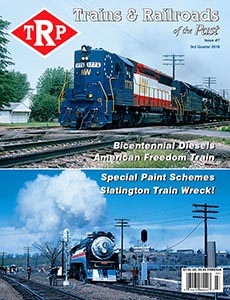By Jaime Serentsis/Photos as noted
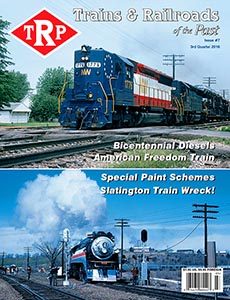 This is just the tip of the iceberg in covering railroads’ celebration of the Bicentennial in the year leading up to 1976. Those of you who were fortunate to have witnessed it firsthand are lucky to have experienced the nation’s biggest party! Bicentennial fever was everywhere, as people were proud to show their love of this country. Everywhere you looked, you saw stars, stripes, ribbons… and everything was red, white and blue, from buses and taxis to garbage trucks and steam rollers!
This is just the tip of the iceberg in covering railroads’ celebration of the Bicentennial in the year leading up to 1976. Those of you who were fortunate to have witnessed it firsthand are lucky to have experienced the nation’s biggest party! Bicentennial fever was everywhere, as people were proud to show their love of this country. Everywhere you looked, you saw stars, stripes, ribbons… and everything was red, white and blue, from buses and taxis to garbage trucks and steam rollers!
The railroads, however, took it to another level. You didn’t see many red, white and blue airplanes, but nearly every railroad entity had at least one Bicentennial unit, and many of them had more than one! Seaboard Coast Line U36B ignited the painting frenzy in 1971 and then it spread like wildfire to every corner of the country. Santa Fe painted five identical SD45-2’s and the Pittsburgh & Shawmut turned their whole fleet of diesels into Bicentennials! Even bankrupt railroads didn’t want to be kept out of the fun. Conrail actually had an unauthorized repaint that was quickly hidden beneath a fresh coat of royal blue once management found out.
Long before the internet, it was the excited phone call from a friend who worked for the railroad, or lived down the line that sent you trackside for that long wait for the big event. Although the railroads often assigned their red, white and blue power to special trains, the passage of even a common freight with a Bicentennial on the point was the catalyst for many railfan gatherings over the years.
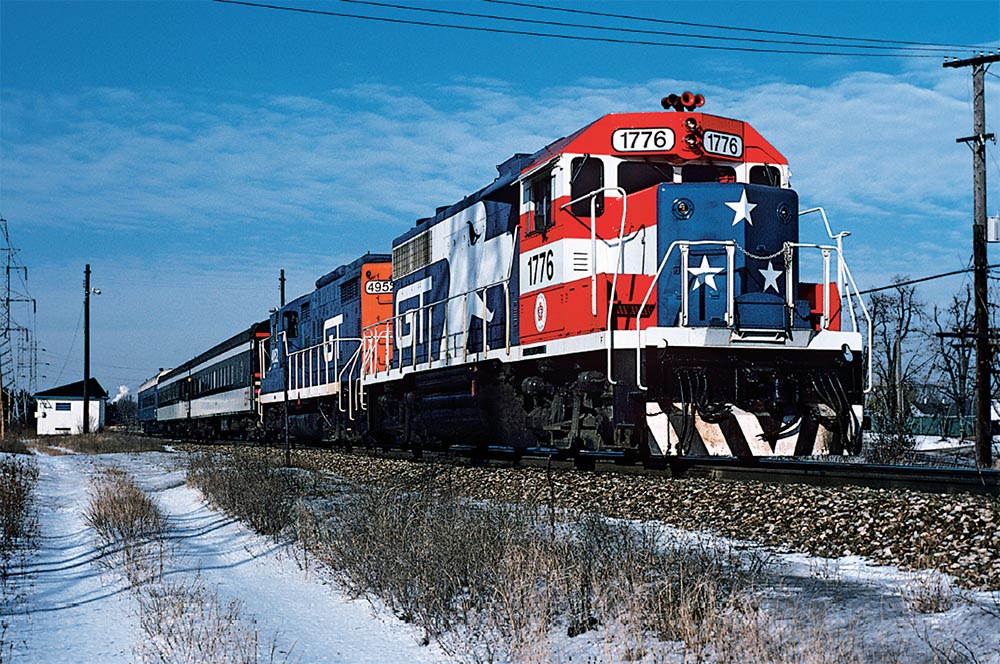 You can thank John Clark Albertson for the bold graphics on Grand Trunk Western’s Bicentennial diesel. He was an employee of the railroad who won a design contest and saw his dream come to life on GP38AC No. 5808, transforming it into GTW No. 1776! GTW was one of many railroads who got their employees or the general public involved with the design of their patriotic diesels. In this view, No. 1776 is leading GP18 No. 4952 with a “Santa Claus Special” at Bloomfield Hills, Mich., on December 11, 1976. Kodachrome by Dennis A. Smolinski
You can thank John Clark Albertson for the bold graphics on Grand Trunk Western’s Bicentennial diesel. He was an employee of the railroad who won a design contest and saw his dream come to life on GP38AC No. 5808, transforming it into GTW No. 1776! GTW was one of many railroads who got their employees or the general public involved with the design of their patriotic diesels. In this view, No. 1776 is leading GP18 No. 4952 with a “Santa Claus Special” at Bloomfield Hills, Mich., on December 11, 1976. Kodachrome by Dennis A. Smolinski
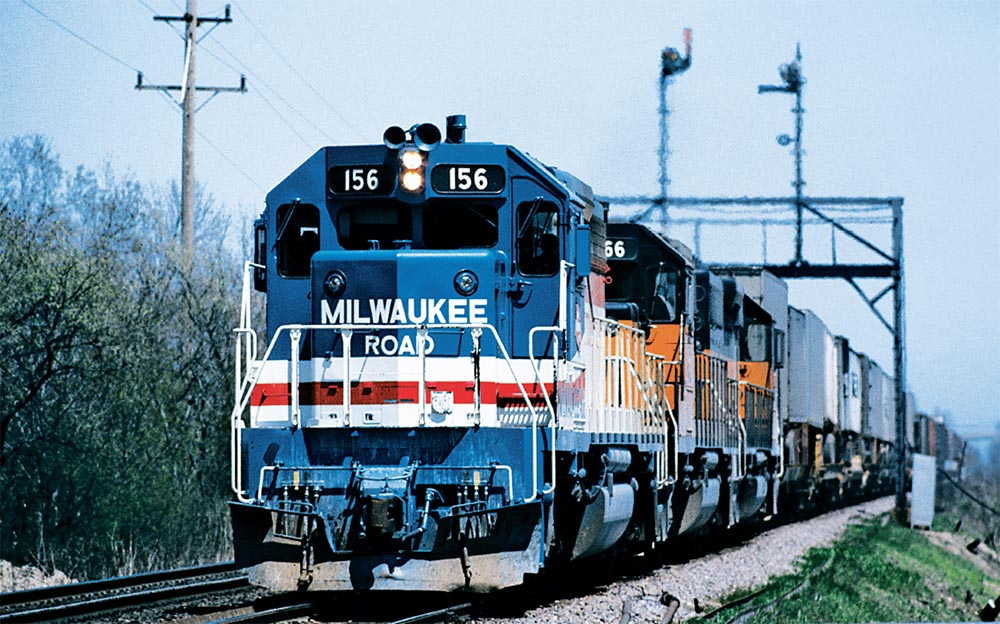 Milwaukee Road Bicentennial SD40-2 #156 looks great on the point of a high priority piggyback train protected by a set of ancient semaphores on a signal bridge at Des Plaines, Ill. Believe it or not, the Long Island Rail Road applied nearly the identical paint scheme on their Bicentennial GP38-2. Not only that, but they also used a generic number that had nothing to do with the celebration, either, choosing the mundane 252, which was as relevant as Milwaukee’s 156. Kodachrome by Tom Post, courtesy of David P. Oroszi
Milwaukee Road Bicentennial SD40-2 #156 looks great on the point of a high priority piggyback train protected by a set of ancient semaphores on a signal bridge at Des Plaines, Ill. Believe it or not, the Long Island Rail Road applied nearly the identical paint scheme on their Bicentennial GP38-2. Not only that, but they also used a generic number that had nothing to do with the celebration, either, choosing the mundane 252, which was as relevant as Milwaukee’s 156. Kodachrome by Tom Post, courtesy of David P. Oroszi
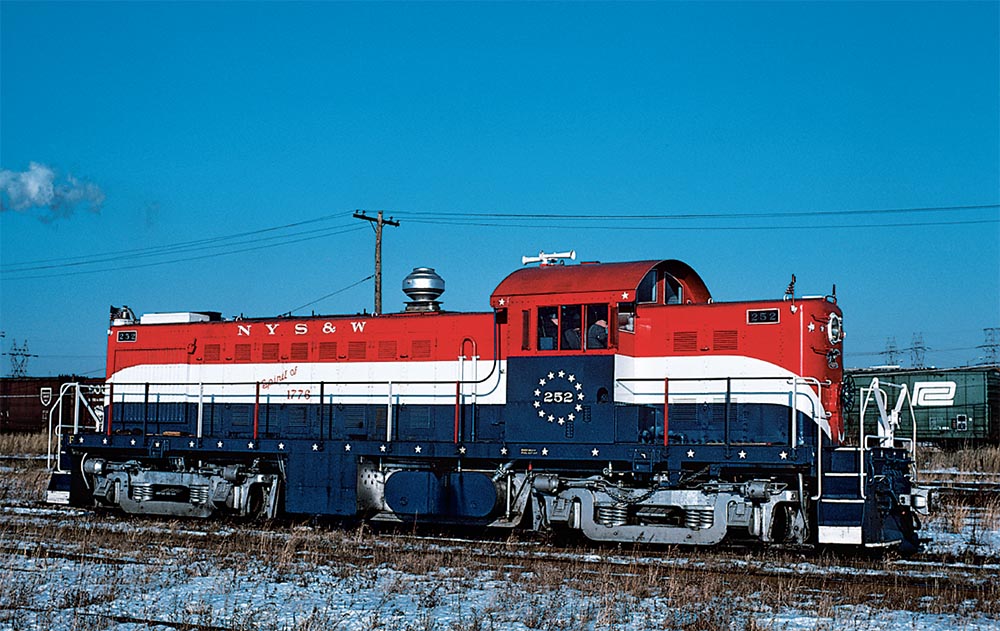 New York, Susquehanna & Western gave this Alco RS1 in a very a bright look, complete with a circle of stars on the cab, silver trucks, a silver stack and even silver couplers. Notice also the small American flags in the four corner brackets. They named it “Spirit of 1776,” but kept the roadnumber 252, which was the same number worn by the nearby Long Island Rail Road’s red, white and blue GP38-2! The RS1 is shuffling around Little Ferry, N.J., on January 31, 1977, under a beautiful blue dome of high pressure. Kodachrome by James P. Marcus
New York, Susquehanna & Western gave this Alco RS1 in a very a bright look, complete with a circle of stars on the cab, silver trucks, a silver stack and even silver couplers. Notice also the small American flags in the four corner brackets. They named it “Spirit of 1776,” but kept the roadnumber 252, which was the same number worn by the nearby Long Island Rail Road’s red, white and blue GP38-2! The RS1 is shuffling around Little Ferry, N.J., on January 31, 1977, under a beautiful blue dome of high pressure. Kodachrome by James P. Marcus
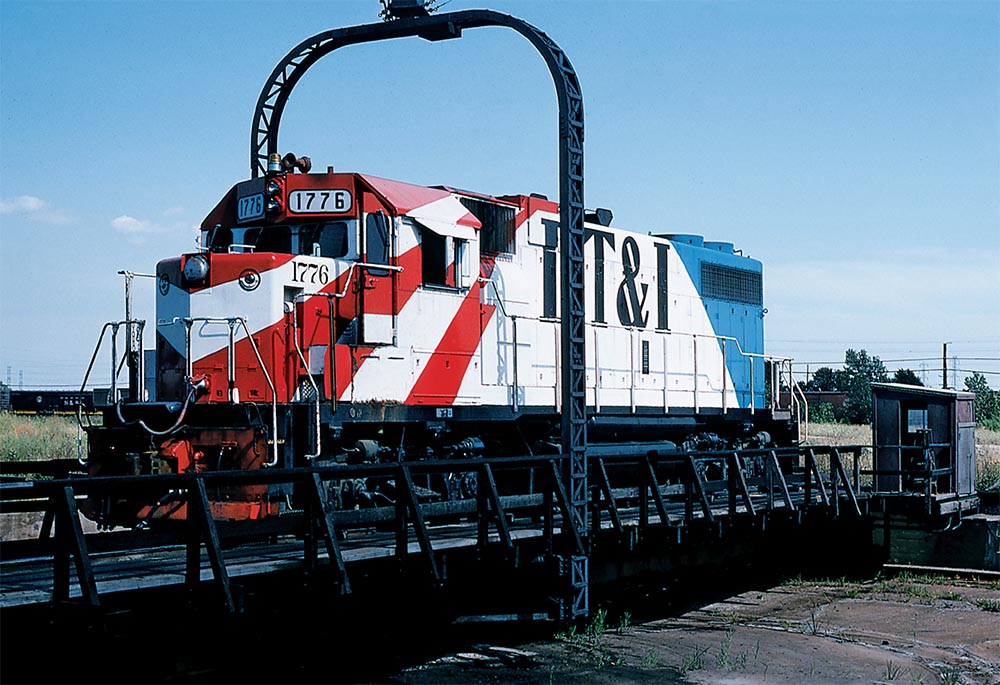 Detroit, Toledo & Ironton’s colorful sunburst Bicentennial DT&I #1776 is taking a spin on the turntable. This GP38-2 looks great from every angle! The 1776 was delivered to the railroad in this dramatic scheme, though it would have carried the number 228 (which it eventually did receive when it was repainted into DT&I’s standard colors). Notice the bell on the nose and the lack of dynamic brakes. They are definitely not needed on the flat topography of this midwestern carrier. Kodachrome by Jim Boyd, collection of Kevin EuDaly.
Detroit, Toledo & Ironton’s colorful sunburst Bicentennial DT&I #1776 is taking a spin on the turntable. This GP38-2 looks great from every angle! The 1776 was delivered to the railroad in this dramatic scheme, though it would have carried the number 228 (which it eventually did receive when it was repainted into DT&I’s standard colors). Notice the bell on the nose and the lack of dynamic brakes. They are definitely not needed on the flat topography of this midwestern carrier. Kodachrome by Jim Boyd, collection of Kevin EuDaly.
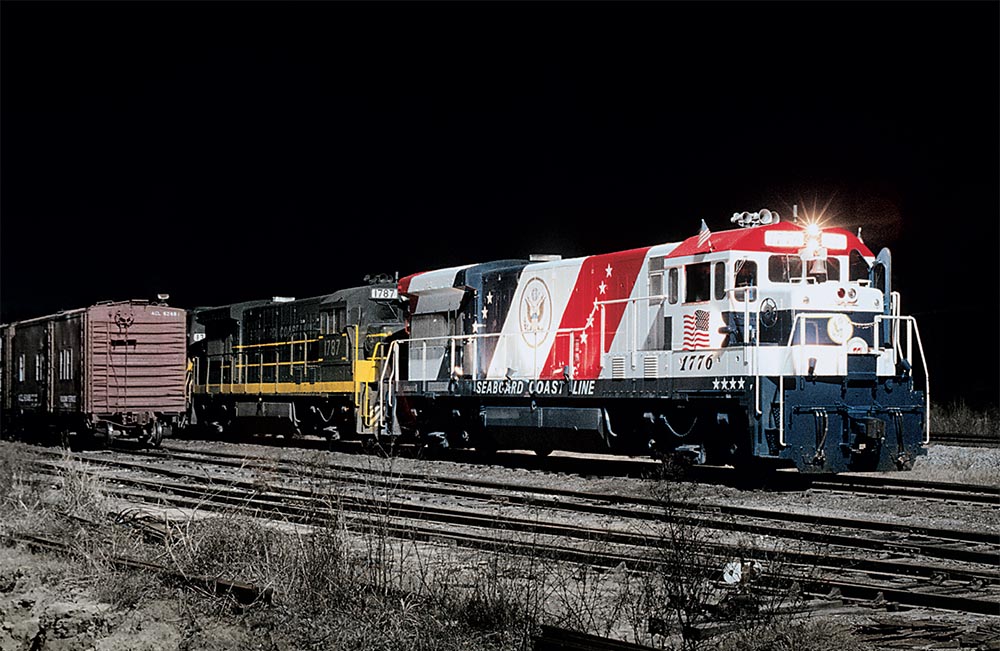 The chicken or the egg is still a mystery, but we do know that the very first Bicentennial diesel was Seaboard Coast Line U36B No. 1776, and it is captured here in a beautifully lit night scene taken on January 21, 1972, at Dothan, Alabama. Note that this was nearly four years before the official Bicentennial celebration. An alert employee of SCL noticed that one of the U36B’s in their upcoming order from General Electric would be the 1776, and the railroad directed GE to deliver one of their husky road units in this scheme — a far departure from their standard jet black look. For the next five years, the red, white and blue paint flowed like water from an open fire hydrant as hundreds of railroads and private operators painted up their own Bicentennial units. In true American fashion, some were relative copies of SCL’s look, some were true works of art and others could only be described as whimsical, with the remainder covering nearly every variation you could think of. Kodachrome by William Harwell, Jr., collection of Kevin EuDaly
The chicken or the egg is still a mystery, but we do know that the very first Bicentennial diesel was Seaboard Coast Line U36B No. 1776, and it is captured here in a beautifully lit night scene taken on January 21, 1972, at Dothan, Alabama. Note that this was nearly four years before the official Bicentennial celebration. An alert employee of SCL noticed that one of the U36B’s in their upcoming order from General Electric would be the 1776, and the railroad directed GE to deliver one of their husky road units in this scheme — a far departure from their standard jet black look. For the next five years, the red, white and blue paint flowed like water from an open fire hydrant as hundreds of railroads and private operators painted up their own Bicentennial units. In true American fashion, some were relative copies of SCL’s look, some were true works of art and others could only be described as whimsical, with the remainder covering nearly every variation you could think of. Kodachrome by William Harwell, Jr., collection of Kevin EuDaly
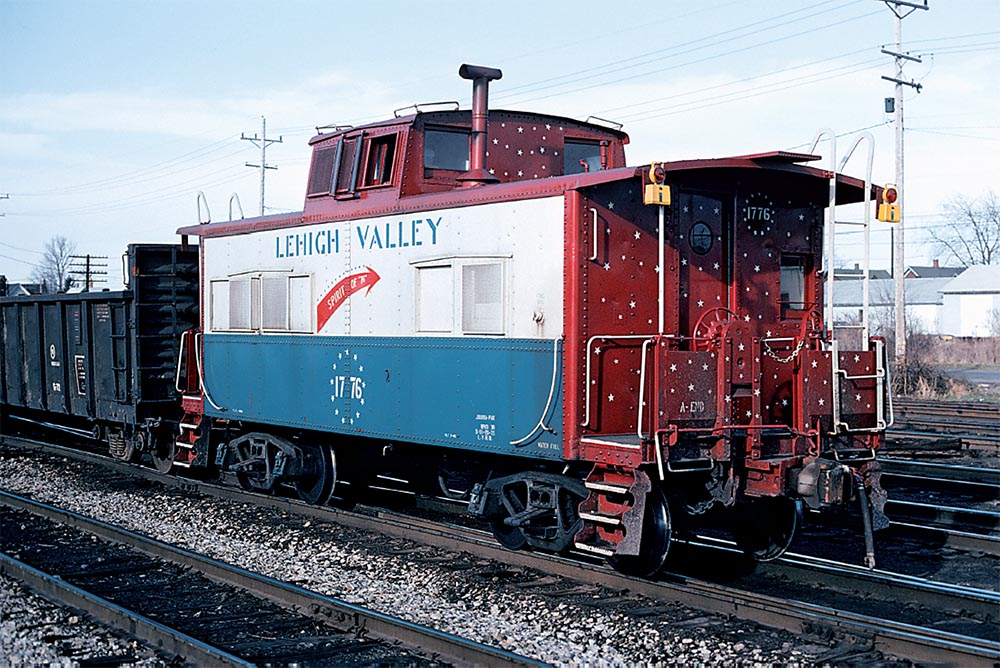 The Lehigh Valley is largely forgotten in discussions about the Bicentennial because they didn’t repaint any diesels for the occasion, although they made a stunning, although short-lived, impression with their star-spangled caboose. LV’s “Spirit of 76” was built in July 1940 and received this patriotic treatment in November 1975, five months later the railroad was folded into Conrail, who quickly repainted the predecessor railroad’s cabooses. Caboose No. 1776 is still looking good as it trails a freight train on March 30, 1976, just two days before the Conrail takeover. Kodachrome by Don Jilson
The Lehigh Valley is largely forgotten in discussions about the Bicentennial because they didn’t repaint any diesels for the occasion, although they made a stunning, although short-lived, impression with their star-spangled caboose. LV’s “Spirit of 76” was built in July 1940 and received this patriotic treatment in November 1975, five months later the railroad was folded into Conrail, who quickly repainted the predecessor railroad’s cabooses. Caboose No. 1776 is still looking good as it trails a freight train on March 30, 1976, just two days before the Conrail takeover. Kodachrome by Don Jilson


